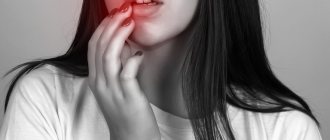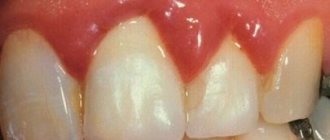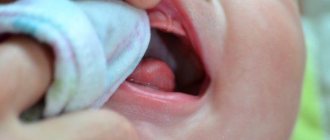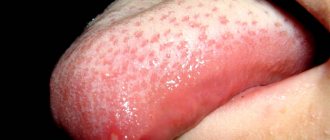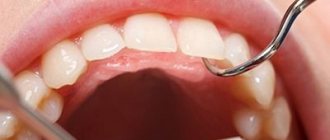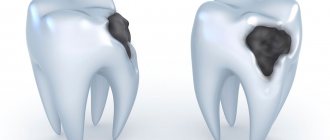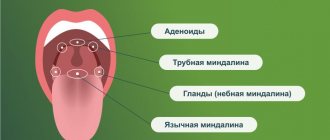From this article you will learn:
- what are the types of gum diseases in children?
- gingivitis in children - symptoms,
- what to do if a child has an inflamed gum.
The article was written by a dentist with more than 19 years of experience.
Gingivitis in children is one of the most common dental diseases in childhood, which is accompanied by bleeding, swelling and redness of the gums. Inflammation of the gums in children is most often a consequence of insufficient oral hygiene - as a result, soft microbial plaque accumulates on the teeth, which causes inflammation of the gingival margin.
In dentistry, such gingivitis is called “chronic catarrhal gingivitis,” and according to statistics, it is observed in 90% of cases (of all cases of gingivitis in children). In the absence of timely treatment, chronic catarrhal gingivitis can transform into “Vincent ulcerative-necrotizing gingivitis.” This is the most severe form of gingivitis, which occurs with ulcerative-necrotic lesions not only of the gums, but also of the oral mucosa.
Gingivitis in children: photo
Gum disease in children also includes the concept of “juvenile gingivitis” - this is juvenile gingivitis in adolescents, which is associated with hormonal changes in the body. Its development may be associated, for example, with the accumulation of sex hormones in the gum tissue, or with the reversible process of hyperplasia of the thyroid gland. Symptoms of juvenile gingivitis are bleeding, persistent swelling of the gingival papillae, and sometimes the growth of the gingival margin on the upper or lower jaw.
The hormone-dependent form of gingivitis can develop in the prepubertal period (i.e., at the age of 7-9 years), or in the puberty period (in girls this is from 12 to 16 years old, and in boys from 13 to 18 years old). Clinical studies show that currently from 83 to 99% of fifteen-year-old adolescents necessarily suffer from one of the forms of gingivitis. But in addition to the forms described above, there are other types of gingivitis that can also occur in children.
Mild course of juvenile gingivitis –
Other forms of gingivitis in children –
- acute gingivitis,
- ulcerative gingivitis (against the background of agranulocytosis, acute leukemia, neutropenia),
- hypertrophic gingivitis (due to blood diseases, while taking medications for epilepsy, during puberty),
- desquamative gingivitis,
- plasma cell gingivitis (allergic),
- drug-induced necrotizing ulcerative gingivostomatitis (the diagnosis is made on the basis of laboratory tests, the results of which indicate sensitization of the body).
Important: we hope that all of the above will allow parents to understand that in the treatment of gingivitis in children there is no place for any kind of self-medication. And in some cases, visiting a dentist is only the first step of treatment, because... Gingivitis in a child can only be a symptom of one of the body’s diseases. In the latter case, consultations with specialized specialists, for example, an endocrinologist, hematologist, dermatologist, allergist, and pediatric gynecologist may be required. It may be necessary to conduct a general blood test (with an extended leukocyte formula), a general urine test, a test for glucose tolerance, as well as tests for the concentration of various hormones in the blood, etc.
Chronic gingivitis in children: symptoms
We have already said above that chronic catarrhal gingivitis is the most common form of gingivitis in children. And its reason lies in irregular oral hygiene. When examining a child’s oral cavity, you may find accumulations of soft microbial plaque in the neck area of the teeth. There doesn’t have to be a lot of microbial plaque (as in the photo below); For inflammation of the gingival margin, a small amount is enough.
Symptoms of chronic catarrhal gingivitis –
- bleeding gums,
- swelling of the gingival papillae (look swollen),
- bad breath,
- pain when brushing teeth,
- redness or cyanosis of the gingival margin - (red gum in a child indicates an acute phase of inflammation, but blue gum in a child indicates that the inflammation is long-term, chronic).
With chronic catarrhal gingivitis, children may not show any complaints at all, and only when questioned can they tell you that their gums bleed a little when brushing their teeth (24stoma.ru). In chronic catarrhal gingivitis, gum pain during brushing usually occurs only during periods of exacerbation (for example, against the background of colds and weakened immunity). But it is during the period of exacerbation of gingivitis that the child may develop a low-grade fever of 37.5°C and/or malaise.
Childhood gingivitis: more about the causes
The main factor in the development of catarrhal gingivitis is soft microbial plaque. Therefore, the answer to the question: why do a child’s gums bleed lies in insufficient quality/regular oral hygiene of your child. By the way, constant snacking between main meals (various snacks, candies, cookies, rolls, sweet drinks) also contributes to the growth of microbial plaque and the development of gingivitis. Insufficient hygiene leads to the accumulation of microbial plaque in the neck area of the teeth.
The bacteria that make up the microbial plaque actively produce toxins and inflammatory mediators, which cause the development of an inflammatory reaction in the gums. The latter is manifested by such symptoms as the development of swelling of the gingival margin (gingival papillae), its redness or cyanosis, as well as bleeding and pain when brushing teeth. In addition, there are additional factors that aggravate the effect of microbial plaque, contributing to the development of catarrhal gingivitis.
Local factors contributing to the development of gingivitis:
- the presence of carious cavities in the teeth,
- presence of overhanging edges of fillings,
- malocclusion (crowding of teeth),
- sharp edges of carious cavities (Fig. 1),
- wearing orthodontic appliances,
- mouth breathing,
- anomalies of attachment of the labial frenulum.
General factors contributing to the development of gingivitis: cardiovascular and gastrointestinal diseases, infectious diseases (including chronic tonsillitis). A special role in aggravating the course of chronic catarrhal gingivitis is played by blood diseases, diseases of the endocrine system (including type 1 diabetes mellitus, thyroid diseases), puberty, hereditary diseases, and oncological diseases.
Treatment of gingivitis in children in the dental clinic
If your child exhibits characteristic signs of gingivitis, make an appointment for your child at the specialized dental clinic “Aesthetics”. High-level children's specialists with extensive professional experience work here.
The center is equipped with modern equipment that allows high-precision diagnostics and painless treatment of any diseases of the teeth and gums. When treating gingivitis in children and adults, qualified dentists use only high-quality medications from reliable global suppliers.
The center has a flexible pricing policy. All patients who leave their reviews on the Aesthetics website are guaranteed a 3% discount on all dental services.
Catarrhal gingivitis in a child: how to treat
Considering that chronic catarrhal gingivitis in children occurs due to the accumulation of microbial plaque on the teeth, the most important step in treatment will be the removal of the causative factor. Therefore, treatment of gingivitis in children should first of all include the removal of dental plaque at the dentist, anti-inflammatory therapy, as well as training in proper oral hygiene.
- Removal of dental plaque –You can remove dental plaque by conducting a session of professional oral hygiene at a dentist’s appointment. Dental plaque is removed using ultrasound, after which the teeth are polished with special brushes (the procedure is painless). In Fig. 2 you can see the ultrasonic tip, which is used to remove dental plaque. Touching the tip of the nozzle to dental plaque causes destruction of the attachment of tartar to the tooth enamel.
Important : to cure gingivitis in children, treatment should primarily consist of removing soft and hard dental plaque using ultrasound. An attempt to use various rinses, gels with antibiotics and antiseptics, toothpastes with herbs (without removing plaque by a dentist) will certainly only lead to a temporary subsidence of inflammation. Drug therapy should be used only after removing tartar and plaque!
- Anti-inflammatory therapy –a course of anti-inflammatory therapy will quickly remove all the symptoms of gingivitis, as well as return loose, swollen gums to their normal state. A child's inflamed gums can be treated with the following dosage forms: antiseptic rinses and applications of anti-inflammatory gel to the gums.
Antiseptic rinses:- 0.05% CHLORHEXIDINE SOLUTION (instructions for the drug) usual course 7-8 days, rinse 2 times a day in the morning and evening - immediately after oral hygiene. It is advisable to rinse your mouth for at least 30-40 seconds, and preferably 1 minute (if the child is old enough). There are no contraindications based on age. The solution has a bitter taste. If the child cannot yet rinse his mouth on his own, then you can use a chlorhexidine solution in the form of spray irrigation.
MIRAMISTIN (instructions for the drug) rinse solution for children from 3 years old. Rinse 4 times a day for 1 minute (for 7-8 days), and for children who are not able to rinse their mouths, irrigate the gums with a spray. Miramistin is somewhat inferior to chlorhexidine in terms of potency, and besides, it is much more expensive (its only advantage in the treatment of gingivitis in a child is that Miramistin solution does not have a bitter taste).
Anti-inflammatory gels, ointments:
Questions are often asked: what to smear on a child’s gums, what gum ointment for children will be best? The best children's ointment for gums, we can probably say, is the drug "Cholisal-gel". Preparations in the form of ointment forms will be a priori less effective on the oral mucosa than gel forms of drugs. The components of ointments do not penetrate the moist mucous membrane, and also do not stay on it (they slide off and are swallowed along with saliva). Therefore, for the oral cavity you need to choose drugs only in the form of gels.
- CHOLISAL (instructions for the drug) Gel for children's gums. Active ingredients: choline salicylate and cetalkonium chloride. It has not only anti-inflammatory and antiseptic, but also analgesic effects. There are no contraindications based on age. It is applied to the gingival margin/gingival papillae – primarily from the front surface of the teeth. The course is usually 7-8 days, but no more than 10 days. Apply 2 times a day (in the morning and in the evening before bed) immediately after the end of the antiseptic rinse. After application, it is advisable not to eat or rinse your mouth for 2-3 hours (you can drink).
If you decide to treat your child yourself , then you need to know that removing dental plaque before starting treatment is mandatory. If anti-inflammatory therapy is used without removing soft and hard plaque, it will cause the following:
→ symptoms (bleeding, swelling, etc.) will certainly decrease or disappear. But, as soon as the course of treatment ends, the symptoms will arise again. This is because the cause of gingivitis (microbial plaque) was not removed and treatment was only given for symptoms.
→ transition of gingivitis from an acute form with severe symptoms to a chronic form with scanty symptoms.
In carious cavities there is a lot of infection, which causes not only tooth decay, but also inflammation of the gums. In young children, the so-called bottle form of caries often occurs, which is associated not only with poor hygiene, but also with improper feeding of the child. When treating caries in children under 3 years of age, as a rule, dental clinics use the method of silvering teeth. Despite the fact that this method does not require drilling of teeth, it has major disadvantages, and is also inferior in effectiveness to other more effective methods of treating caries in children (read more in the link above).
Prevention of catarrhal gingivitis –
WHO (World Health Organization) experts have identified the following main measures for the prevention of gingivitis:
- Proper oral hygiene –
firstly, it includes the correct technique for brushing the child’s teeth and gums, depending on the age. After all, many parents simply don’t even know at what age a child’s oral hygiene should begin. And you need to start it even before the first teeth erupt (for more information about the rules of oral hygiene in children, see the link above). - The choice of children's toothpaste - secondly, toothpastes can provide significant assistance to parents in the fight against caries and gingivitis in their children. In this case, baby pastes with special components (aminofluoride, xylitol, hydroxyapatite, a complex of lactic enzymes, etc.) that can compensate for hygiene deficiencies to a certain extent can come to the rescue. For more information about the rating of children's toothpastes, read the article at the link above.
- Balanced nutrition for children - thirdly, it is very important to follow a diet (avoid snacks between main meals), and also limit the intake of easily digestible carbohydrates - flour, sweets, cookies, as well as sweet drinks, for example, sweet soda and juices. Easily digestible carbohydrates should be given to the child only immediately after meals. After which you need to brush your teeth for 5 minutes.
Symptoms of gum inflammation in a child
Symptoms of gum disease vary depending on the type and form of the disease. These include:
- bleeding and pain;
- unpleasant odor from the mouth;
- purulent discharge;
- deposits of plaque or tartar;
- hypersensitivity.
Most often, childhood gum disease is associated with the development of gingivitis. The inflammatory process occurs due to poor oral hygiene (bacteria multiply).
REFERENCE! If you have problems with your gums, a visit to the dentist is required. Only a specialist will select an individual treatment algorithm based on the symptoms.
Vincent's ulcerative-necrotizing gingivitis -
This form of gingivitis can occur with severe symptoms of intoxication of the body. Visually, with this form of gum inflammation in children, the gums will be covered with a whitish or yellowish coating, there will be areas of gum ulceration, and some of the gingival papillae will be necrotic. In the acute course of Vincent's gingivitis, patients complain of putrid breath, fever, loss of appetite, headaches, as well as severe bleeding and pain in the gums. In a chronic course, the symptoms are similar, but are less acute.
The causes are ulcerative-necrotizing gingivitis Vincent most often develops against the background of untreated chronic catarrhal gingivitis - against the background of a progressive deterioration in oral hygiene, or against the background of a sharp decrease in immunity as a result of infectious diseases (including against the background of tonsillitis, chronic tonsillitis), or with the presence of severe concomitant chronic diseases (blood diseases, HIV, etc.). You can read more about the symptoms and treatment of this form of gingivitis in the article at the link above.
Treatment methods
Some of the common childhood gum diseases include:
- stomatitis (inflammation of the mucous membrane due to a virus or fungus);
- periodontitis (advanced form of gingivitis);
- periodontal disease (associated with inflammation, rarely diagnosed);
- gingivitis (a consequence of injury or plaque, usually occurs in the catarrhal form, during the eruption or change of teeth).
For treatment, local administration of various medications and rinsing with antiseptics may be prescribed. Additional measures: sanitation of the oral cavity and removal of tartar. In the chronic form, physiotherapeutic methods are used.
Hypertrophic gingivitis in children –
Hypertrophic gingivitis in children is a chronic inflammatory process of the gums, occurring with a predominance of proliferation processes (which is accompanied by an increase in tissue volume). This form occurs in 3-5% of all cases of gingivitis in children. There are two forms of hypertrophic gingivitis - 1) edematous, which occurs with persistent swelling of the gingival papillae or the gingival margin as a whole, 2) fibrous, in which fibrous growth of gum tissue occurs.
Hypertrophic gingivitis in adolescents: photo
Predisposing factors for its development:
- The period of puberty - which is associated, on the one hand, with the stimulating effect of sex hormones on the proliferation of the gum epithelium, and on the other hand, with an increase in vascular permeability in the gum tissue and the formation of excessive vascular and cellular reactions (due to which the gums may respond with the development of persistent swelling and hypertrophy even to ordinary stimuli, to which there is no reaction under normal conditions). In this case, ordinary irritants should also be understood as the usual obligate microflora of the oral cavity, which under normal conditions is not pathogenic for humans. We have already said above that such gingivitis is often also called juvenile or juvenile.
- Long-term untreated chronic catarrhal gingivitis - in combination with other provoking factors.
- Drug-induced gingival hyperplasia due to – 1) long-term treatment with anticonvulsants; 2) taking calcium channel blockers - such as nifedipine, amlodipine or verapamil; 3) taking the immunosuppressant cyclosporine-A.
- Vitamin C deficiency.
- Crohn's disease.
- Endocrine diseases, as well as blood diseases (leukemia, myeloid leukemia, thrombocytopathies, etc.).
- Chronic mechanical trauma to the gums, which is always present in patients with a deep bite, crowded teeth, when wearing braces and other orthodontic devices, as well as in the presence of overhanging edges of fillings.
Gum inflammation in children due to somatic pathology:
Important: most often, hypertrophic gingivitis occurs with a combination of predisposing factors. For example, during puberty in children who simultaneously have malocclusion (crowding of teeth, open or deep bite, small vestibule of the oral cavity). Or during puberty - if the child has untreated chronic catarrhal gingivitis, which we described in detail above, etc.
Medicines for gingivitis
The medications your child needs are prescribed only by a doctor, based on the clinical picture of the disease and the individual condition of your child. Self-medication in this case is unacceptable, as it can lead to significant complications, including osteoporosis of bone tissue.
What to smear
Gels and ointments are applied after rinsing the mouth. The surfaces are pre-dried with a cotton swab or gauze.
Holisal.
The gel has a good anti-inflammatory and analgesic effect. Apply three times a day to the affected areas of the gums.
Apident active.
An ointment based on natural ingredients that quickly relieves pain and inflammation. The composition is applied to the inflamed areas and rubbed in with gentle circular movements.
Solcoseryl.
Used to heal bleeding areas, the gel is applied to both sides of the gums. Use as prescribed by a doctor.
Asepta gel.
Mainly prescribed for the treatment of chronic gingivitis. The drug relieves inflammation, pain, and itching well. Apply 2-3 times a day depending on the severity of the condition.
How to rinse
Important. Alcohol tinctures should not be used for rinsing, as their use will lead to even greater irritation.
Rinsing is mandatory when carrying out anti-inflammatory therapy. Carry out after each meal and additionally throughout the day. For young children, parents apply applications using cotton swabs soaked in solutions. In severe cases, treatment of the oral cavity and gums is carried out in the dental office.
For rinsing the following is prescribed:
- Chlorhexidine 0.05%.
Use after every meal. Rinse your mouth vigorously for 30 seconds. - Furacilin.
Use a ready-made 0.02% rinse aid or dissolve one tablet in a glass of boiled water. The drug disinfects the oral cavity well. - Furamistin 0.01%.
It has a powerful antibacterial effect and is used after meals. - Herbal infusions.
Prepare at home in accordance with doctor's recommendations.
Important. Before using solutions, rinse your mouth with clean water to remove any remaining food.
Antibiotics
In the chronic stage and in severe forms of the disease (ulcerative, ulcerative-necrotic), as well as in cases of high risk of complications, antibiotics are prescribed. The doctor selects the drug and dosage individually.
Desquamative gingivitis in a child –
Desquamative gingivitis in a child is manifested by soreness of the gums when brushing teeth, swelling and bleeding of the gums (most often this form of gingivitis occurs in the area of the front teeth). Upon examination, you can find that the gums have a bright red color, they are usually sharply painful on palpation, and have a loose consistency. Due to the loss of keratin, the gums become more susceptible to traumatic effects.
Desquamative gingivitis in a child, teenager -
Desquamative gingivitis most often develops against the background of untreated chronic catarrhal gingivitis, i.e. as a result of the long-term influence of bacterial pathogens on the gum mucosa. Factors contributing to the disease are metabolic disorders, infectious diseases, Crohn's disease or other somatic pathologies. In addition, desquamative gingivitis can be a symptom of dermatoses - such as lichen planus, pemphigus vulgaris.
Very often, desquamative gingivitis occurs during puberty (more often in girls). The latter is due to the fact that in girls during puberty the hormone progesterone predominates, and the concentration of estrogen, on the contrary, is reduced. A decrease in estrogen content leads to a decrease in cell keratinization and partial loss of the protective keratinizing membrane of the gum.
Pericoronitis, symptoms and types
With pericoronitis, the symptoms largely depend on the form of the disease - acute or chronic. Acute pericoronitis is characterized by:
- Aching intense pain in the area of the cutting tooth, the pain intensifies under the influence of food and mechanical irritants (hygienic procedures, chewing, touching, etc.).
- Difficulty chewing food, complicated swallowing. A few days after the onset of inflammation, it becomes difficult to open the mouth and severe pain appears.
- Swelling and hyperemia of the mucous membrane.
- Enlargement of regional lymph nodes, sometimes the lymph nodes become painful when touched.
- Externally noticeable swelling of the cheeks a few days after the onset of the inflammatory process.
- General deterioration in health - weakness, lethargy, prolonged low-grade fever (increased temperature to 37-37.5 degrees).
- Bad breath, which is caused by the decomposition of food particles and the active activity of microorganisms in the “hood” space.
Acute pericoronitis can occur in a serous (catarrhal) or purulent form: in the first case, the signs of inflammation are more pronounced, the pain is more intense, and there is no purulent discharge. In the second case, purulent exudate flows freely from the inflammatory focus, due to which tissue tension is somewhat reduced and the symptoms are less pronounced. A person may feel like their condition is gradually improving, when in fact the infection is simply spreading to other tissues in the mouth.
If treatment for acute pericoronaritis was not carried out or was carried out at home, the disease gradually becomes chronic: the severity of symptoms decreases, while exacerbations of pain and discharge of pus into the oral cavity are periodically observed. In this case, there is a high risk of developing severe complications.
Plasma cell gingivitis (allergic) –
With plasma cell gingivitis, we see that the gum has a bright red color, as a rule, it is swollen and increased in size (in the initial stages and a limited volume of the lesion - the volume of the gum may not be increased). The process consists of plasma cell infiltration of the gum, namely its subepithelial layer. Infiltration of the gums by plasma cells occurs as a hypersensitivity reaction to certain antigens - especially often to various flavors or spices.
Plasma cell gingivitis in a child, teenager -
Thus, an allergic reaction can occur to the components of chewing gum, toothpastes, and lollipops. Plasma cell gingivitis often develops in children due to cinnamon and other flavorings contained in baked goods and confectionery products, as well as various drinks. Often the cause can be absolutely any product containing natural herbal ingredients.
Treatment should consist of identifying and eliminating the causative factor (allergen). In case of a generalized, pronounced process and the formation of periodontal pockets, local anti-inflammatory treatment is additionally carried out in combination with systemic antibacterial therapy with azithromycin. Early correct diagnosis is very important, because plasmatic gingivitis has similar clinical manifestations in the oral cavity, which can be observed with leukemia, HIV infection, discoid lupus erythematosus, lichen planus, and desquamative gingivitis.
Causes of inflammation and swollen gums during teething
The main prerequisites for the development of pericoronitis are:
- Mechanical injuries to the gingival tissue over the tooth germs due to hard foods, too hard toothbrushes, as well as due to other damaging factors.
- Long-term or difficult teething.
- Favorable conditions in the mouth for the accumulation of bacterial plaque and food particles under the gingival margin (insufficient hygiene, peculiarities of microflora in the oral cavity).
Swollen gums during teething are easily susceptible to traumatic influences, which leads to the development of inflammation. In this case, teething itself can be difficult for the following objective reasons:
- Dense bone tissue in the “eight” zone; bone compaction is most often formed because there are no milk teeth in this zone.
- There is not enough space for the “eight” in the dentition.
- Thickening of the gums and periosteum in the posterior part of the jaw is usually explained by the characteristics of embryogenesis.
Even one of these factors can cause the disease.
Gingivitis against the background of herpetic stomatitis –
Very often, with viral herpetic stomatitis, concomitant acute gingivitis occurs. In this case, the periodontal papillae and the marginal part of the gums increase due to swelling and become bright red. Read more about gum inflammation due to stomatitis in the article: “Treatment of various forms of stomatitis in children.” We hope that our article on the topic: Gingivitis in children treatment was useful to you!
Sources:
1. Dental education of the author of the article, 2. Based on personal experience as a dentist, periodontist, 3. The European Academy of Paediatric Dentistry (EU), 4. National Library of Medicine (USA), 5. “Pediatric therapeutic dentistry. National leadership" (Leontyev V.K.).
Prevention
The main preventative rule is daily brushing of teeth twice a day (morning and evening). It is important not to forget about the palate and tongue. Please also pay attention to the following recommendations:
- caries is immediately healed (it is advisable not to start the disease in the early stages);
- it is also necessary to treat the disease that could provoke gum inflammation;
- malocclusion needs correction;
- with the help of good nutrition and taking multivitamin complexes according to age, they strengthen the immune system;
- during teething, use a special fingertip to massage the gums;
- food and drink for the baby cannot be too hot or, conversely, cold;
- They explain to their son or daughter that food is always experienced on both sides.
REFERENCE! It is the parents' responsibility to monitor how thoroughly and correctly the child brushes his teeth.
Our specialists at modern pediatric dentistry “Avesta” believe that timely preventive measures help minimize the development of a serious disease. This is the easiest way to keep your baby's gums and teeth healthy.
Pericoronitis, treatment in children and adults
It should be noted right away that for pericoronitis, treatment at home can only reduce the symptoms of inflammation, but not solve the problem. Therefore, all home methods (rinsing with antiseptics, applying anti-inflammatory ointments, etc.) can only be used as a way to relieve inflammation during the eruption of wisdom teeth and reduce pain - this is a temporary measure before visiting the dentist.
In a dental clinic, in case of complicated teething, treatment will depend on whether the problem tooth should be preserved or whether it should be removed. If preserved, the doctor performs surgical excision of the “hood” under local anesthesia. This eliminates conditions for the accumulation of food and the growth of bacteria, and also facilitates teething. After excision of the “hood,” the patient is prescribed antiseptic therapy (rinses, baths) and, if necessary, antibiotic therapy.
In cases where tooth extraction is indicated due to their incorrect position on the jaw, lack of antagonists, or insufficient space for full eruption, the doctor immediately removes the problematic tooth and prescribes antiseptic therapy to the patient.
In some cases, at the initial stages of the inflammatory process, conservative therapy can be preliminarily applied - local treatment with antiseptic rinses and the introduction of an iodoform tampon into the “hood”. However, local therapy does not always give a positive result; moreover, it is appropriate only at the initial stage of the disease; in other cases, surgical intervention will be required.
When it comes to teething in children, treatment is always aimed at preserving the teeth (except for those cases when dystopia is clearly expressed and the doctor sees that preserving is useless).

